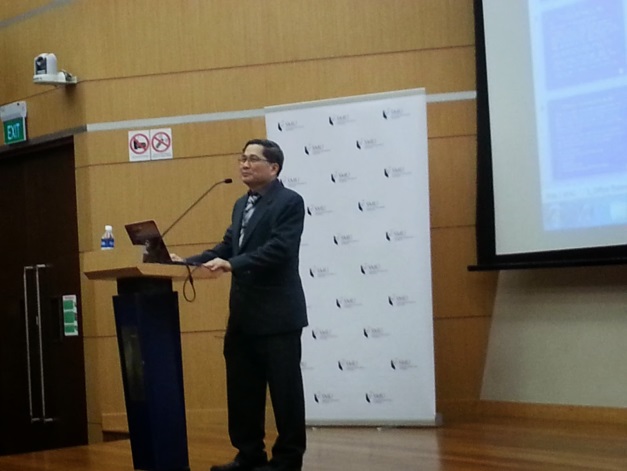
Unveiling the Benefits of Technical Analysis
 |
 |
|
SMU’s Lee Kong Chian School of Business (LKCSB) and Sim Kee Boon Institute for Financial Economics jointly organised a public lecture on ‘Mathematics of Intra-day Technical Trading’ on 21 March 2014. Delivering the lecture to a full crowd in the Mochtar Riady Auditorium, Professor Lim Kian Guan, who is the OUB Chair Professor of Quantitative Finance from LKCSB, examined the importance of Technical Analysis (TA) in financial economics and capital markets. Comprising the essence of technical day trading, TA uses past historical prices, trading volumes and patterns to predict future price movements for profit gains. Common methods used include trend analysis, pattern analysis, gap analysis and relative strength index that estimate shifts in demand and supply of stocks. Professor Lim first established the isomorphic relationship between: 1) trigger and exit strategy of technical analysis, and 2) sub-martingale stopping time theorem and optimal stopping in probability mathematics. By demonstrating the core mathematical ideas and acumen that underlie TA, he affirmed its positive contribution to stock yields. This insight was certainly the most important takeaway for traders and investors who formed the majority of the audience. He went on to challenge the conventional view that prices are martingales (price processes with zero expected profit) and that charting of prices has limited use. “It is important to distinguish that prices are not martingales using empirical measures, although discounted prices are martingales under risk-neutral measures,” he clarified. “Where there is drift (a trend in stock price movements), correct stopping times capture the profits with appropriate considerations for risks in the form of draw-downs or draw-ups (consecutive falls or rises in prices). Even when drift is uncertain, filtering strategy can still capture expected profits when the filter is optimally chosen to be small enough but larger than the spread,” he observed. However, the caveat is that risks can sometimes wipe out realised profits, just as overly frequent trading may drive costs up. Professor Lim also noted that in situations when unobserved hidden factors are driving demand and supply, TA could help uncover missing patterns that correlate with these factors, thus making the market more efficient. While intra-day behavioural patterns of momentum or reversal trading represent rational responses to estimations of drift, they may not necessarily be connected to notions of price over-reaction or under-reaction in longer-term investing. In his conclusion, he emphasised that the availability of direct market access, server co-location, algorithmic trading, and dark pools had made day technical trading capable of offering higher returns but at higher risks. It is an area that deserves more research in terms of theory, empirical back-testing and forecasting. |
|
See More News
Want to see more of SMU Research?
Sign up for Research@SMU e-newslettter to know more about our research and research-related events!
If you would like to remove yourself from all our mailing list, please visit https://eservices.smu.edu.sg/internet/DNC/Default.aspx

